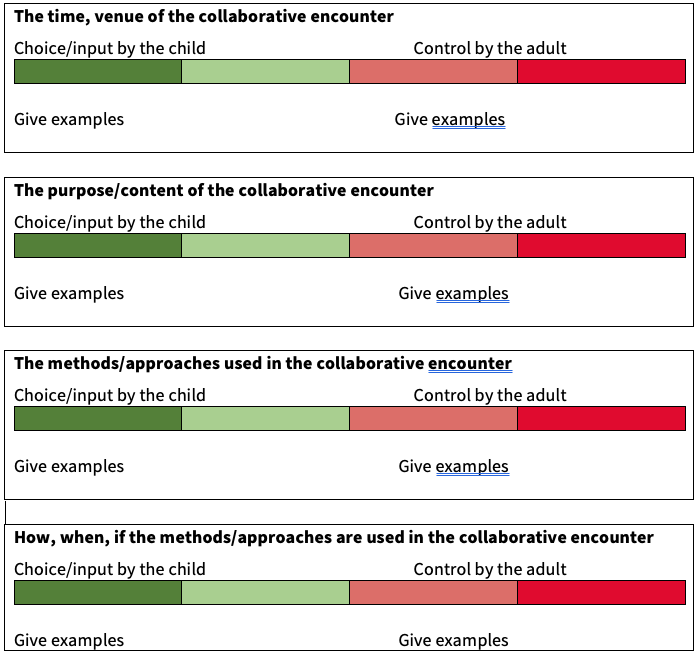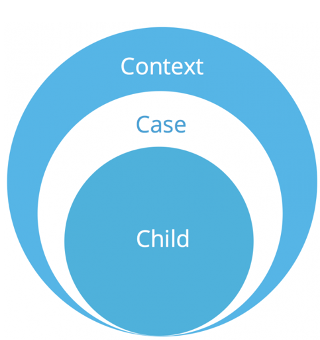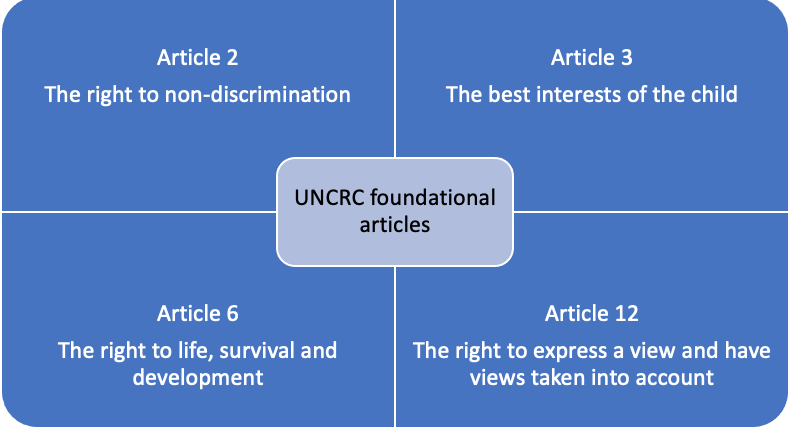Exercises – Methods and tools
Section A
Knowledge about methods/approaches
Purpose of exercise
The purpose of the following exercises is for participants to reflect on the methods and approaches for collaborating with young children thata) they are familiar with
b) they have used
c) they would like to use
Useful background: Methods and tools, Communication processes and skills.
Instructions
Everyone is given a piece of paper or uses a writing document if they are online.
Everyone draws three columns and adds their answers to the three columns (see below).

After 10 minutes, the facilitator should bring participants together to share their answers. The facilitator should help participants reflect that methods and approaches are endless and that they can be themed in several different ways. They can be themed according to the type of activity – creative, arts-based, play based (board games, card games, toys, sand, water, playdoh) digitally based (iPads, Smartphones, computers, play stations), activity based (indoor and/or outdoor). They can also be themed according to factors such as cost, cultural norms, and levels of confidence required.
Section B
Attitudes, biases and assumptions
Purpose of exercise
The purpose of this exercise is for the group to explore their experiences of collaborating with young children using various methods and approaches.
Instructions
The facilitator invites participants to work in pairs to share with each other one example of a method/approach they have used when collaborating with a young child. Participants are asked to reflect firstly on the child, case and context (taken from Talking and Listening to Children)
The facilitator invites participants to reflect on the following aspects of their work indicating where on the form they are rating the collaborative encounter (download the form).

- The facilitator invites participants to consider any obstacles in the methods used in their collaboration with the child and how and in what ways the collaboration could be improved.
- The facilitator then invites participants form some feedback on the exercise. The facilitator should draw out professionals’ attitudes, biases and assumptions towards collaborative encounters with young children and how the methods and approaches help facilitate, enable and support young children to access their participation rights.

Section C
Opportunities using outdoor methods and/or activities
Exercise C1
Purpose of exercise
The purpose of this exercise is to encourage participants to define outdoor methods and activities.
Instructions
- The facilitator invites participants to consider together the following questions:
- How do we define and understand outdoor activities?
- What opportunities are there in your context for outdoor activities?
- Why might outdoor activities be beneficial as part of collaborative encounters?
- When and where could you engage in outdoor activities with young children?
- What principles should underpin these encounters?
Exercise C2
Purpose of exercise
The purpose of this exercise is to engage participants in designing an outdoor activity with a child aged 10-12 years old to develop reciprocal social skills.
Instructions
- The facilitator invites participants to break into small groups with 2-3 people in each group and to think about an experience they have with doing outdoor activity with a group of children at their workplace (or alternatively to imagine doing an outdoor activity with a group of children who are in contact with the child welfare services). The groups are invited to explore the following questions:
- What experiences do they have with the age group 10-12 years?
- What informs and shapes their experiences? (upbringing and outdoor activities, work experiences, personal lives).
- How might their experiences influence their approach to children aged 10-12 years who have experienced neglect?
- The facilitator brings the groups back together to reflect on key messages/learning from this exercise.
- The facilitator invites participants to break into groups of 3-4 people to consider the case study below:
Scenario: Sarah, a girl at the age of 11, has been living her whole life together with her mother. Father unknown. Rest of her family lives far from their hometown. Social services have got to know Sarah through her mother. Suffering from depression since Sarah was little, in and out of jobs. Periodic welfare benefits have helped out through stressful periods. Sarah is often home from school and her teachers worry about her. She has told others about her interest in animals, dancing and being with friends. She has also told others that she often feels lonely. Her mother is hoping for a change in Sarah`s emotions, relations, activities, and everyday life. Sarah has said yes to attend an outdoor activity next week. She will meet 5 other children in that session.
- Still in their groups, the facilitator invites participants to consider the following questions:
- What activities are available in their context and local community?
- How can they introduce possible activities to Sarah with the intention of her participating in the group?
- What obstacles might Sarah have in her mind?
- How would they approach these obstacles in dialogue with Sarah?
- How can they give Sarah agency in the process of joining the group?
- How could the group be used to help Sarah develop a social life?
- Which tools could be used to further develop social skills, etc. mastering through action, joy and belonging?
- What framework/structures would the group make?
- The facilitator invites the group back together and discusses key messages/learning.
- The facilitator invited the group to view the Vimeo: “Experiences from outdoor therapy” on the website: reacch.eu/media library/methods and tools)
- The facilitator invites the group to discuss what they would do differently next time in a similar situation/setting (with children 10-12 years)?
Section D
Creating dialogue with children exposed to violence (aged 7-9)
Purpose of exercise
The purpose of this exercise is to develop skills in creating dialogue with children aged 7-9 years old regarding everyday life and feelings in situations where they are exposed to violence.
Instructions
- The facilitator ensures that all participants have access to My feelings workbook.
- The facilitator invites participants to break into small groups with 2-3 people in each group and to discuss:
- What experiences do they have with children aged 7-9 years old?
- What experiences do they have of working with children who have experienced violence?
- What experiences do they have of violence (what have they read, heard, seen on TV or, if comfortable to disclose, what have they experienced). NB: there is no expectation that participants should disclose.
- What informs and shapes their views (for example, types of violence, impacts of violence, responses to violence)?
- How might their views, feelings and experiences influence their approach to and communication with children aged 7-9 years old who have experienced violence?
- How might a child’s views, feelings about and experiences of violence affect their desire to open up to share experiences?
- What cultural aspects might influence a child’s openness about violence? ….
- The facilitator brings the groups back together to reflect on key messages/learning from this exercise.
- The facilitator invites the group to form small groups of 2 people each and engage the case study below which aims to help Emma concretize and put into words her experiences, feelings and make sense of these.
Scenario: Emma, aged 7, has been subjected to psychological violence by her parents and experienced mild physical violence. Emma now lives temporarily with her aunt. You work in child protection and will talk to Emma about her everyday life and her feelings. Use My feeling workbook and simulate a conversation with “Emma” (played by a colleague).
- The facilitator brings the groups back together to reflect on the following questions:
- What were the experiences of using the tool My feelings workbook?
- How did they get Emma’s attention and who took the lead in the communication?
- How do they think the child experienced the situation?
- In what contexts could this tool be used and what challenges are there?
- What would they do differently next time in a similar situation/setting (communication with a younger child)?
Section E
Creating dialogue with younger children exposed to neglect (aged 4-6)
Purpose of exercise
The purpose of this exercise is for participants to help the child to understand experiences in their everyday lives when they are experiencing neglect, to contribute to the child’s creation of meaning and the development of self-confidence.
Instructions
- The facilitator should ensure that participants have access to conversation pictures (See page 12, Methods and tools.)
- Conversation pictures can visualize events and feelings and may help to promote children’s storytelling.
The facilitator invites participants to break into small groups with 2-3 people in each group and to discuss:
- What experiences do they have working with children ages 4-6 years old?
- What experiences do they have of working with children who have experienced neglect?
- What experiences do they have of neglect (what have they read, heard, seen on TV or, if comfortable to disclose, what have they experienced). NB: there is no expectation that participants should disclose.
- What informs and shapes their views (for example, types of neglect, impacts of violence, responses to neglect?
- How might their views, feelings and experiences influence their approach to and communication with children aged 4-6 years old who have experienced neglect?
- How might a child’s views, feelings about and experiences of neglect affect their desire to open up to share experiences?
- What cultural aspects might influence a child’s openness about neglect?
- The facilitator brings the groups back together to reflect on key messages/learning from this exercise.
- The facilitator invites the group to form small groups of 2 people each and engage the case study below which aims to help Lukas put into words his experiences, feelings, views and make sense of these.
Scenario: Lukas, aged 4, has been neglected by his parents. You work in child protection and are going to talk with Lukas about his everyday life. Use relevant “conversation pictures” and simulate a conversation with Lukas (played by a colleague). Start with an introduction, a neutral image/picture and open questioning, gradually you can use images that invite conversation about troubled experiences, and always end with an image evoking hope and good feelings.
- The facilitator brings the groups back together to reflect on the following questions:
- What were the experiences of using the tool “conversation pictures”?
- How did they catch Lukas’s attention?
- Who took the lead in the communication?
- How do they think the child experienced the communication?
- In what contexts could this tool be used?
- Do they see any challenges using this tool?
- What would they do differently next time in a similar situation/setting?
Section F
Creating dialogue with infants and toddlers (aged 0-3)
Purpose of exercise
The purpose of this exercise is for participants to help the child understand good and bad experiences in their everyday life to contribute to the child’s creation of meaning and the development of self-confidence.
Instructions
- The facilitator should ensure that participants have access to some or all of the following – conversation pictures or faces with feelings, kitbag, dolls, or a children’s book (books for small children on specific topics such as parental substance abuse, violence, neglect, parental psychological difficulties) (for example. For further ideas see Reacch resources and Tools and Methods.
The facilitator invites participants to break into small groups with 2-3 people in each group and to discuss:
- What experiences do they have working with children ages 0-3 years old?
- What informs and shapes their views (for example, previous jobs, personal lives)
- How might their views, feelings and experiences influence their approach to and communication with children aged 0-3 years old?
- What cultural aspects might influence a young child’s communication.
- The facilitator brings the groups back together to reflect on key messages/learning from this exercise.
- The facilitator invites the group to form small groups of 2 people each and engage the case study below which aims to help participants work out how to explore the good and bad experiences in Phil’s life in a way that cares for Phil and his mother:
Scenario: Maria, a young mother aged 21 and her son Phil two years old, live together in an apartment in the suburbs. Maria has been in an on/off relationship with Phil’s father Jack. Social services came in contact with the family after a domestic violence report sent from the police. Phil goes to kindergarten twice a week while Maria study at the University. Phil is showing strong frustration at home and Maria has asked for help to handle his emotions. She is concerned that her son has been traumatized by witnessing violence in his own home. She is also showing a lack of confidence in being a mother.
The facilitator invites the groups to select a tool and simulate some communications (with colleagues taking on the roles of Phil and Maria).
The facilitator invites the participants to come back together and discuss the following questions:
- What were their experiences of using the tools?
- How did they catch Phil’s attention?
- Who took the lead in the communication?
- How do they think Phil might have experienced the communication?
- In what contexts could these tools be used?
- Do they see any challenges using these tools?
- How did they reassure, support, and encourage Maria?
- What would they do differently next time in a similar situation/setting?
Section G
Bringing skills, methods and UNCRC knowledge together
Purpose of exercise
The purpose of this exercise is to bring together skills, methods and UNCRC knowledge to support participants to create opportunities to engage and collaborate with young children and to contribute to the efforts of their team/organisation to do this too.
Instructions
- The facilitator reminds the participants of the interrelated, indivisible and inalienable four pillars of the UNCRC as follows:
The facilitator emphasises these four pillars:
- All children regardless of age (article 2) and any other background factor have a right to express their views and have these considered (article 12);
- We cannot determine what is in the best interest of the child (article 3) unless their views (article 12) are included and considered as part of the best interest’s decision-making;
- We must seek all ways and means to seek the views of all children regardless of their age and any other background characteristic to ensure that children’s article 6 rights are also protected and promoted.

This is because the invisibility of children known to social services (and caused by lack of engagement with them) has directly contributed to their deaths at the hands of abusive carers/parents; and
- In addition to the four pillars articles 5 and 13 remind us that children’s capacities develop in different ways in different cultures and contexts and that adults should be flexible and responsive to this. Furthermore, young children have a right to receive and impart information in and through any medium of their choice. This could include through outdoor play/outdoor activities.
The facilitator provides all participants with the checklist: Basic requirements for implementation of article 12 rights. In pairs the participants are invited to reflect on how this might help their own teams and organisations.
The facilitator draws attention to other relevant local, regional resources of help.
Ending the session
The facilitator asks the group to reflect on:
• One new thing they have learned
• One new thing they will do differently in practice
• One new thing they will ask their team, organisation to consider in terms of policy/practice changes